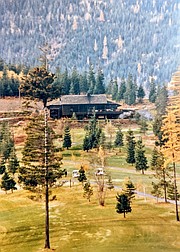Shoshone Golf Club approaches 100-year anniversary
There are very few establishments in the Silver Valley that have stood the test of time.
From natural disasters to economic downturns, hundreds of businesses (both big and small) have unfortunately met their demise for one reason or another here.
This makes the fact that the Shoshone Golf Club in Big Creek is closing in on its 100-year anniversary all that more impressive.
Opened in 1922, former director of Golf and Golf Pro for the course, Sano Haldi explains that the course has endured several changes over the years — but still carries on today.
Much like most businesses in the Silver Valley, the Shoshone Golf Club has its roots in the mining industry.
“Professional people like doctors and mining executives decided in 1921 that they needed a place to play golf,” Haldi said.
With the help of the Sunshine Mine, a 3-hole course with sand greens was opened up in the Big Creek Drainage (on the now current impoundment area for mining waste) in 1922.
Haldi explained that it isn’t uncommon for many golf courses to start out with sand greens.
“They didn’t have the appropriate irrigation to keep the grass green.”
The link with the mine was so close that even the timber used to build the old club house was sourced from the same St. Maries based supplier that the Sunshine Mine used for its mining timers.
With Big Creek running right through the old property, the course was consistently under the threat of flooding and other unfavorable weather related issues as well. It wasn’t uncommon for flood water to rise up and cause all sorts of trouble for the golfers.
While this first course in the drainage would evolve over time as it’s membership (and the community of Big Creek as a whole) grew, the Shoshone Golf Club would ironically have to move to higher ground because of the mining company that put it where it was in the first place.
In the early 1960s, an entire housing development in Big Creek that had been built by the mining company needed to either be demolished or moved (some of these homes still stand today in Osburn and Kellogg) to make room for the new tailings pond.
“They had to build a tailings pond to take care of the mining waste,” Haldi said.
While the construction of this tailings pond would not immediately force the golf course to move, it certainly set the stage.
Roughly 20 years later, this first tailings pond would become condemned, forcing the mine to construct another to the south — where the golf course was.
It was in the late 1970s that the Sunshine Mine approached the members at the golf club with the idea to move the course somewhere else. This is how the Shoshone Golf Club made its move to its current location.
Haldi remembers this time well, as it was from 1973 to 1978 that he ran the Shoshone Golf Club at its old location.
“The sunshine had several options for us,” he recalled. “Because of the beauty of the (current) property, we selected that one. When I was at the old golf course, my two sons and I used to climb up there on that hill. We always said, ‘what a perfect place for a golf course.”
With an agreement in place between the company and the member’s owned Golf Club, the process to move the course onto the hill began in late 1978.
Haldi remembers the last games of golf on the course well, as they were held during the ’78 Labor Day Weekend Tournament.
From that weekend until June 1979, there was no golf to be played anywhere in Big Creek.
The process of moving was a quick one, mostly because it had to be.
With the pressure on to clear out the old golf course, the club house was burned down instead of demolished due to time restraints to build the new tailings pond.
During this moving period, Shoshone Club members worked out a deal with the nearby Pinehurst Golf Course to play there.
Shortly after the Shoshone Golf Club moved back to Big Creek on June 27, 1979, the new course had the honor of being broken in by none other than legendary golfer, Samuel Snead, in July of that same year.
Snead was one of the top professional golfers in the world for the better part of four decades and is still regarded as one of the greatest players of all time.
During the construction of the new course, the landscape was changed very little, as the area already had reasonably flat land to develop on.
For decades, Haldi would be part of the Shoshone Golf Club as director, pro golfer and greens keeper.
Since the move, the layout of the course has changed very little. It remains a 9-hole course with two sets of tees, allowing for an 18-hole game experience.
What has changed though is the yardage for each hole and the addition of women’s tees. These changes were made to accommodate older and newer golfers coming to the course.
Today, Haldi explains that the Shoshone Golf Club currently lacks a director and is suffering from a lack of new players.
His hope is that new management (whoever that may be) can find a way to get younger golfers up to the course and get them interested in the sport.















